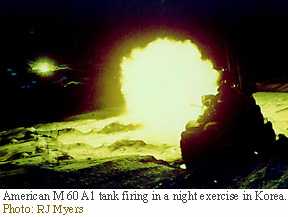

|
|
 The Korean War The Korean WarThe Cold War between the Communists and the Western Worlds began in earnest at the end of World War II. In order to maintain political prestige among the uncommitted nations of the world, neither side could allow the other any advantage or concession. The Soviets tried to blockade Berlin, and the West answered with the Berlin Airlift (1947-49). In Korea, the armies of both the U.S. and USSR withdrew, but each side armed their respective section of the country. The North Koreans clamored for unification and fomented several armed uprisings in the South in the late 1940s. However, South Korea did not collapse, but grew stronger. This may be why North Korea launched a massive surprise attack against the South on June 25, 1950. The first year of the Korean War was an incredible seesaw: Seoul (in the middle of the peninsula) changed hands four times. The remaining two years of the war became a brutal bashing of both sides along a heavily defended battle line, whose location changed only slightly from month to month. The final cease-fire line showed no significant gain for either side. A sequence of 27 maps adapted from the West Point Atlas of American Wars has been assembled here to vividly show the dynamics of battle. The sequence may be viewed as a QuickTime movie. In brief, the Korean War began with the invasion of the South by North Korean troops. Troops in the South were unprepared and were pushed into a small corner of South Korea in a matter of weeks. The situation was quickly reversed by the first United Nations (UN) offensive in the southeast, coupled with a daring high-tide landing at Inchon near Seoul. The landing forces quickly cut the North Korean supply lines, forcing the now unsupported North Korean armies to flee back north. The UN armies pressed north of the 38th parallel with the intent to take over North Korea, and the disorganized North Korean army was unable to stop them. A few UN units actually pressed north to the Amnok (Yalu) River, the border between Communist China and Korea. The Chinese warned that they would not accept the conquest of North Korea by the UN and massed for a counter attack. Though less well armed than the UN armies, the Chinese armies were much larger and quickly overwhelmed the UN forces. Some 40,000 U.S. troops were cut off by the advance and evacuated from near Wonsan in mid-December 1950. Seoul was retaken by the Chinese as they pushed south. This time, the Communist forces were stopped about two-thirds of the way down the peninsula. A second UN offensive began in late February 1951, which pushed the Chinese back north of Seoul again. The UN advance stopped near the 38th parallel. A second Chinese offensive was launched in April. Once again, huge waves of Chinese soldiers cut off and destroyed advance UN troops.
The result of the Korean War was a stalemate, ending not far from where it began. Was the war a loss for the UN and the United States? Many viewed it as such, even while the war was still being fought. General Douglas MacArthur, World War II hero and commander of the UN forces in Korea, wanted complete victory in Korea and advocated attacking bases inside Communist China that were supporting forces in North Korea. But U.S. President Harry S. Truman and other leaders of the UN forces feared that attacking China would lead to a larger conflict that could easily plunge the entire world into World War III. These leaders felt that the human misery and political humiliation associated with pursuing a limited war was preferable to the much greater loss and doubtful outcome of a global war. As it was, Truman was President and Commander-in-Chief; MacArthur was his subordinate. When MacArthur persisted in his opposition to Truman's political and military objectives, Truman replaced MacArthur with a general willing to pursue a limited war. The Korean War, the first shooting conflict of the Cold War, remained confined to the Korean peninsula. The fact that it did not expand into a wider war helped confirm the West's policy of containment of Communism, a policy which dominated most international relations during the Cold War. Was containment a misguided policy? On the one hand, it prevented a major war. On the other hand, it led to a seemingly endless string of small, bloody battles all over the world: Cuba, Central Africa, South East Asia, Afghanistan, and many others. Containment also led to massive infusions of economic and military aid by leading nations of both the Communist and Western worlds into developing nations considered to be of strategic importance, while others were bypassed. Repressive political regimes were supported in many poor nations in the name of containment. The debate over containment continued through armed conflicts in the 1960s, nuclear stalemate in the 1970s, and on into the present.
[
Korea Yesterday ] [ Old Choson Period ] [ The Three Kingdoms ] [ Home ] [ Teacher Pages ] [ Modules & Activities ] |
HTML code by Chris Kreger
Maintained by ETE Team
Last updated April 28, 2005
Some images © 2004 www.clipart.com
Privacy Statement and Copyright © 1997-2004 by Wheeling Jesuit University/NASA-supported Classroom of the Future. All rights reserved.
Center for Educational Technologies, Circuit Board/Apple graphic logo, and COTF Classroom of the Future logo are registered trademarks of Wheeling Jesuit University.